
Working and Principle :
The light from monochromatic source is made to fall on an optically plane glass plate inclined at an angle of 45° to the vertical, where it gets reflected on to the plano-convex lens. The wavelength of monochromatic light source is determined from the radii of the interference rings.